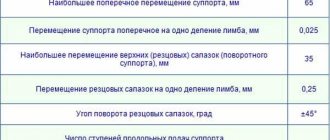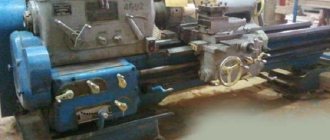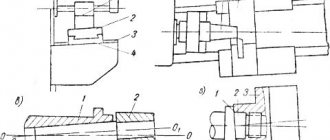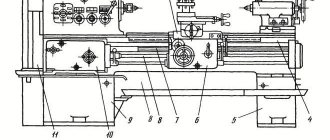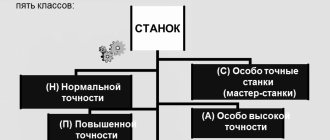Training on the basis of vocational schools, schools, technical schools, retraining and advanced training programs - all this is impossible without relatively safe, limited-capacity, but at the same time multifunctional equipment. This is exactly how one can characterize the screw-cutting lathe TV 3, also known as TVSh-3, which is often called a school machine. This is a fairly lightweight device that does not require complex installation with the construction of the most rigid platform, but at the same time it allows for most basic turning operations.
Description
This turning and grinding device was produced at the machine tool plant in Orsha. Immediately after the start of production, it was noted that the unit was relatively inexpensive and met all the standards of that time. Later, the device also demonstrated good reliability and durability in use. Even today, repairing a unit and replacing its key components is relatively inexpensive.
In addition, the machine is distinguished by its versatility compared to other devices of its class. It is widely used in various areas of production and to perform various works, which include:
- Polishing parts (after replacing the wheel).
- Chamfering, grinding and processing of metal parts.
- Sharpening and grinding of drilling and turning tools.
- Sharpening of any metalwork tools.
It is noteworthy that this device is often sold complete with a special vacuum cleaner that cleans work surfaces of industrial waste. Based on the technical and functional features of the machine, it is most often used in small enterprises, but it can also be found in home workshops.
It is worth noting that for home use this unit may be too powerful or too large.
Design features
The TSh 3 machine, at first glance, is similar to its predecessor models - the TSh 1 and TSh 2 machines. The machine has a classic layout - an electric motor is installed on the bed, which drives the working shaft.
Each of the grinding heads, which are mounted on the shaft, has protective devices with a through hole for installing the elements being processed. Fixation of workpieces is carried out using special platforms, which are located near each working unit.
Other design features of the machine include:
- To protect the operator from production waste, transparent shields are installed above the working areas.
- The design of the device includes a lamp to illuminate the work area.
- Dimensions allow the device to be installed in small spaces.
- A special relay blocks engine operation if the permissible load is exceeded.
- Extreme rigidity of the frame is ensured by special metal sheets with stiffeners.
- The bed is designed in such a way that the operator has the ability to control the parameters of the working area.
- The height of the machine allows you to work on it even without a workbench, but before installing the machine on the floor, you should check its levelness and accuracy.
Key changes in the design of the machine, compared to previous models in this line, were made to increase operator safety and simplify his work with the machine. The materials from which the key components of the unit are made significantly increase the durability of its operation.
Principle of operation
How exactly TV 3 works is reasonable to consider based on the description of the kinematic diagram. The main functional movement is the rotation of the workpiece clamped in the headstock spindle chuck. Power transmission for this process is carried out from the main drive through a V-belt drive. In this case, it is possible to change the rotation speed by changing the gear ratio of the gearbox gears. The possibility of reverse rotation of the workpiece is also provided.
The second functional movement provided by the kinematics of the machine is working with a cutting tool. The approach to the processing zone can be carried out either manually, by rotating the corresponding wheel, or mechanically. For the latter, a feed box and a running roller are used. These two structural elements transform the cyclic rotation of the main drive shaft through a transmission device into a longitudinal/transverse, purely translational displacement of the caliper with a toolholder block.
The movement step of the caliper is regulated by the feed box by changing the gear ratio to select the required rotation speed of the lead screw. To change the depth of cut or the amount of material removed during turning, the mechanics of shifting the caliper tool holder in the transverse direction are used. This is achieved by using a sled design driven both mechanically and by a manual adjustment wheel designed for this purpose.
The TV3 machine allows you to cut threads manually by adjusting the position of the cutter with the corresponding feed wheels in the longitudinal and transverse directions. A mechanical method with transmission of torque from the main drive is also available. In this case, it is necessary to repeatedly pass the cutter over the workpiece. The mechanical cutting method shows much higher accuracy of work, with reduced requirements for personnel qualifications.
The TV 3 machine provides for installing a chuck on the tailstock quill cone. This allows you to cut internal and external threads using a wide range of taps and dies. Also, this functionality is convenient for drilling blind and through holes in workpieces and performing boring operations.
Machine structure
The figure shows the key components of the unit.
- Device drive.
- Bed.
- Spindle head.
- Caliper.
- Rear grandma.
- Electrical equipment.
It is worth talking in more detail about the electrical equipment of the unit. The operator is protected from electric shock by means of working insulation and a ground wire. The electrical equipment is located in a special box at the back of the device. The box closes tightly using a lid with two screws, one of which serves as a grounding connection.
There is a cylindrical type guide on the frame, which, together with the flat frame guide, is the basis for the main mechanisms of the device. On the left side of the headstock there is a bracket to which the machine drive electric motor is attached.
Under the protective casing of the bracket there are elements of the rotation drive and feed drive. Under the casing of the front part of the frame there is a screw for moving the caliper (longitudinal).
Device
The TV3 design uses a classic layout; the equipment consists of the following functional elements:
- The frame connects all the main elements and serves as the main rigidity and strength basis of the structure. It has two cabinets made of sheet metal. In the front part there is a unit with a lead screw and a rack. On the top there are guides for moving the carriage and tailstock block.
- The machine is equipped with a transmission mechanism located in the headstock block. The transmission of rotational torque from the main drive is carried out using a V-belt drive. The gearbox shaft, by positioning the gears, transports power to the spindle, the speed of which varies with one gear ratio or another.
- Gearbox. This unit receives torque from the spindle-type headstock through the interaction of the gears of the transmission device. Feeding is available both by means of a roller and a feed screw.
Other basic nodes are also quite familiar:
- electrical equipment unit;
- tailstock;
- apron;
- protection casings;
- caliper block.
Since the design of the TV-3 machine is somewhat simplified, due to its limited energy capacity, the equipment lacks some protective mechanisms. In particular, there is no lever for locking the handles, there is no dial, and it is impossible to accurately move the caliper by a certain number of dial divisions. Also, the mechanism for forced spindle braking is not presented. The machine is so simple in design that it does not require specialized maintenance or repair.
System and controls
Key control units are shown in the diagram.
- Handle for adjusting the feed movement. With its help you can activate the caliper and select the direction of its movement.
- Main movement adjustment knob. Activating the forward or reverse movement of the spindle stops its operation.
- Handle for moving the caliper (transverse).
- Handle for moving the tool holder.
- Handle for fixing the quill.
- Handle for moving the caliper (longitudinal).
Technical indicators
The scope of application and class of the device are determined by its main technical characteristics. The dimensions of the machine also play an important role. This machine has the following dimensions:
- length – 137 cm;
- height – 60 cm;
- width – 60 cm;
- weight – 220 kg.
The maximum outer diameter of the machine's grinding wheels is 40 cm. The inner diameter of the grinding wheel is 12.7 cm. The working shaft of the unit rotates at a speed of 950 rpm. The maximum cutting speed is 20 mm per second. The power of the electric motor is 3 kW.
Specifications
Even in comparison with the average screw-cutting lathe, the description of the characteristics of the TV3 model allows you to immediately understand the purpose of this equipment. The unit indicators are as follows:
- the maximum diameter of the workpiece or part intended for processing when installed above the frame is 100 mm, in the area of the lower support area - 90 mm;
- lifting of the center axis above the frame guides - 100 mm;
- the spindle allows you to clamp and process rods with a diameter of up to 14 mm;
- center distance - 350 mm;
- maximum carriage feed rate (turning length) - 350 mm;
- number of gearbox shift stages - 6;
- the feed has three speed positions;
- the headstock has a spindle hole for installing workpieces with a diameter of 15 mm;
- spindle speed from 120 to 170;
- main drive power 600 W;
- The tailstock quill offset is 65 mm, a handle is provided to fix the position;
- The displacement of the caliper in the longitudinal direction is 300 mm, in the transverse direction - 100 mm.
The weight of the machine is only 280 kg, dimensions are 1430x470x1010 mm for length, width, height, respectively. The design of the tailstock provides for the installation of the chuck on a standardized cone.
Tips for use
Before starting to operate the unit, you should check the grounding of the machine and the condition of the protective covers. Particular attention must be paid to the serviceability of the electrical cable and plug. Before starting to process parts, let the machine run for a few minutes in idle mode.
When working with the device, adhere to the following recommendations:
- The play between the grinding wheel and the workpiece should be half the thickness of the object.
- The unit should be installed on the floor or a special workbench, taking into account the weight of the machine. The device must stand securely and not wobble, otherwise it will negatively affect the accuracy of workpiece processing.
- The parts to be turned should be placed above the horizontal line that passes through the center of the grinding wheel. Handles are installed taking into account this need.
- The machine operates from a three-phase network with a voltage of 380 V.
- You cannot start working on the unit if it has grounding problems.
- The bed and other components of the device require regular maintenance and cleaning from production waste.
- When working with the machine, you should wear safety glasses and appropriate clothing.
- There should be no explosive materials or flammable substances in the room where the machine is installed.
- A device with damaged or inoperative components must not be used under any circumstances.
- You should start working with the workpiece only after the main shaft has been fully untwisted. Otherwise, the operator risks causing damage to himself or the machine.
Video: review of the TSH-3 lathe.
Scope of application of the machine
Due to its simplicity, good technical characteristics, and ease of maintenance, the TSh-3 universal table lathe has become quite widespread.
It is successfully used in large industries, in the production of small batches of parts, in municipal organizations, car services, and home workshops. In all industries, he is able to efficiently perform the following operations:
- drilling and boring holes of various diameters;
- cutting off a part of a workpiece of a given length;
- surface treatment of parts of various geometric shapes (conical, cylindrical, shaped);
- milling of various parts of complex parts;
- thread cutting using cutters, dies, taps;
- preliminary grinding and final polishing of surfaces;
- sharpening of metalworking, plumbing, woodworking and household tools.
Modernization of a lathe allows you to expand the number of operations performed. The use of additional equipment allows processing of workpieces from various types of wood: sawing, planing, jointing. The TSh-3 machine can produce coiling of springs.
It is used for operations on small prefabricated and welded structures. It is capable of performing basic turning and grinding operations on parts made of powder materials, non-ferrous metals, alloys, and mineral ceramics. The accuracy class of the processing operations performed corresponds to level “N”.
The main advantages of this unit are its simplicity of design, compactness, low weight, low price, high reliability and ease of maintenance.
Important nuances
Like any other mechanisms, the components of this machine can fail. Here are the most common breakdowns and approximate ways to fix them:
- If the bearings in the machine are knocking, they should be replaced as soon as possible. By continuing to operate the machine with faulty bearings, you jeopardize the performance of other machine components.
- The motor makes too much noise or gets hot quickly. In this case, it is necessary to monitor the condition of the motor winding or completely replace it.
- The reason for the sudden stop of the motor may be a malfunction in the electrical network or problems with the starting mechanism.
- A malfunction of the electric motor is also indicated by its inability to reach full speed. This often happens due to problems with the electrical supply or due to a motor failure. If a problem with the electrical network constantly interferes with work, you should purchase a special stabilizer. If the engine itself is faulty, then it will have to be replaced.
It is not recommended to disassemble the machine yourself unless absolutely necessary. But if a breakdown is discovered and you are sure that you can fix it, then before disassembling the machine it should be completely disconnected from the power supply. After this, disassemble the problem unit and try to fix the damage.
Remember that it is much easier to prevent breakdowns than to fix them! To increase the service life of the machine, adhere to the following recommendations:
- Follow all instructions for using the machine.
- Clean the main components of the unit regularly and in a timely manner.
- Check the condition of the electrical network and electrical equipment of the machine.
- Lubricate all running parts of the device in a timely manner.
Republished by Blog Post Promoter
Lathe TVSh-2
It’s like with a Jeep: tuning can be added to a quarter of the cost of a Pepelats, it will look more fun, but it will run as before, but recouping these costs later is more than problematic. It’s easier to immediately take another device - a more serious one.
To be more precise, labor productivity on such equipment will be monotonically low. Whatever they put there. We gain in speed due to improved display, but we still lose in the number of operations due to low withdrawal rates (and additional processing).
This is not an attempt to isolate something alien, but - Alas! — personal NOT fun experience. If you got it for free, great! But if you buy, then immediately something decent (and complete), so that later you don’t have to run around looking for the 2nd gear for the 3rd gear (as I had to - it’s no longer so easy to find something separately even for the more popular than TVSh, balalaikas).
Yes - you can buy a damaged G. inexpensively, but as soon as you start counting (and even more so - scraping) ... An additional set. gears in the guitar for threads (metric-inches, standard - pathetic to disgrace). Frequency generator (it would be nice not to bother with switching + get full power from the 1st phase). A set of vibration supports, so that if without a foundation (and who puts one under this equipment!) it does not make noise and does not move on the floor, weld a new base from a 150-gauge channel so as not to bend to death. Over time, it will become clear that a tabletop version will be more convenient (more compact) - which means you can also build a rack for it. It is advisable to shake up the electrics (at least - a decent 3-phase gas station instead of fuses), normal switches, an LED lamp - instead of a wretched lamp, normal buttons, a 3-phase plug-socket, a tachometer would be nice (so as not to deal with knobs using tables), the starters there are shovel type (TV-4) - .. you’ll find now, either one (reverse by hand), or just 1 ruble for a modern reversible one, etc. There is a lot of equipment in any way: a cartridge like this, a cartridge like that, a driving chuck, a plan washer, a rolling pin for alignment and adjustment, templates for boring jaws FOR EACH TYPE of chuck (ours is ours, the Pole is his), keys for tool holder and cartridges, different centers (KM1 and KM2, regular, persistent, fungal), a steady rest would be nice (at least one is movable, and you’ll find it!). Just using cutter holders for STRICTLY 12th size - you can go broke, it's a total bummer! But the 16th is still in weight, and the plates for them are replaceable (including ours, inexpensive) - IN ABUNDANCE!! If there is somewhere to sharpen 16s to size 12, great! And if not, it’s a reason to think about NGF...
Even if he took it for 25, then the same amount flies away instantly and easily. And this despite the fact that the LABOR is YOUR OWN, no one will pay for it...
In short, this monologue is just a reason to think before purchasing whether you are ready to spend time, effort and money on such an “adventure”, understanding in advance that there is no smell of “commerce” here...
